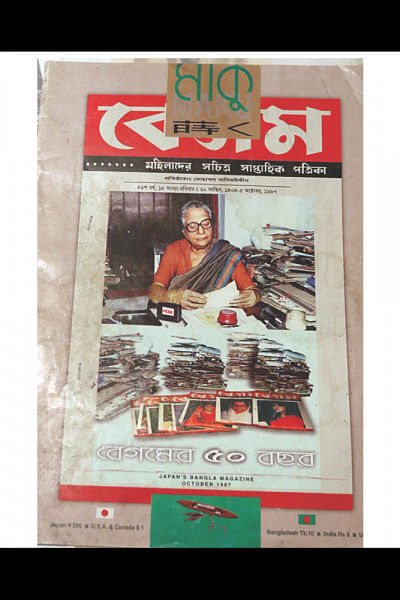All the torchbearers

The excerpt (translated) above is not from 2016. It is from an article written by Hamida Banu, which was published in the 21st December 1947 issue of the weekly Begum, only five months after the magazine came out.
Sixty-nine years ago when Muslim Bangalee women had just begun to obtain education, finding a platform to write about their birth rights and gender equality was not easy. Begum provided that platform; in fact, it encouraged women to come out and make their voice heard.
According to women's rights activist and researcher Maleka Begum, Begum is no weekly magazine as such. It is an institution.
She described how a magazine created awakening among the Bangalee Muslim women. "It is that kind of institution which kindled the spirit of women in remote corners of the country."
The history of Begum starts with Mohammad Nasiruddin, a progressive journalist who worked relentlessly for equality in the society, across gender, class, ethnicity and religion.
Nasiruddin, editor of Shawgat, wanted to bring women into journalism and so he started a yearly women's issue titled Janana Mahal in 1927, whereas one issue of the monthly Shawgat would be dedicated exclusively to women, with writings by women from around the country.
However, Nasiruddin felt one single issue for women a year was not doing much to improve the situation of women in journalism. So in 1945 the last issue of Janana Mahal came out and on July 20, 1947, a month before India's partition, weekly Begum was first published in Kolkata.
Begum's first office was in Kolkata's Park Street and its first editor was poet and rights activist Begum Sufia Kamal. Nurjahan Begum, Begum's current editor, was its acting editor then.
The first issue of Begum had the picture of the pioneer female educationist Begum Rokeya Sakhawat Hossain. Five hundred copies were printed, each costing 25 paisa.
Since women at the time hardly came out of the house without male chaperon, they would send their writings through a male relative. The initial writings were mostly poetry, fiction, cooking recipes and sewing techniques. The magazine became quite popular among women so much so that its Eid volume was priced at Taka 2 at that time.
Four months after the first publication, Nurjahan Begum became the editor of the magazine.
In 1950, the magazine shifted to Dhaka along with Nasiruddin's family and its new office was set up at 66 Loyal Street in Old Dhaka's Patuatuli.
In the new country, Begum continued its publication despite the strict conservative attitude that existed in the then East Pakistan.
"Literature came before journalism and Begum began to bring out the dormant talent of Bangalee women by giving them a place to express their thoughts," said Maleka Begum.
She described how the establishment of Begum Club at the magazine's office helped develop women writers. Begum also printed the social, political and cultural discussions that took place in the club, giving women a voice in the journalistic arena.
"It initiated the beginning of female journalism not through any training but through practice," said Maleka, noting the important role the magazine played through the 50s, 60s and 70s.
Begum currently comes out monthly costing Tk 10. Flora Nasreen Khan, eldest daughter of Nurjahan Begum, now helps with the editing and other job of the magazine, although most of the decisions about the contents and advertising are made by nonagenarian Nurjahan.
"Begum has been Amma's soul," she said adding that she along with her younger sister Rina Yasmin Ahmed would continue to uphold their family legacy.
"It was started by my grandfather and we will carry on the work from the family," she said.
(Sources: Star Weekend Magazine Volume 4 Issue 37, March 11, 2005, Banglapedia, Selected collection of 'Begum' by Maleka Begum published by Oitijjya and interview with Flora Nasreen Khan and Maleka Begum.)

 For all latest news, follow The Daily Star's Google News channel.
For all latest news, follow The Daily Star's Google News channel. 



Comments